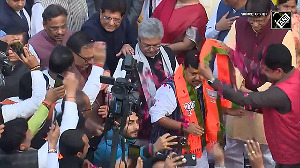AzaadiSAT had around 75 small payloads developed by schoolgirls of 75 rural schools.

'Namaste World: From the G20 presidency.'
This was the first message an 8-kg micro-satellite developed by 750 girl children of rural India sent after reaching orbit.
AzaadiSAT was part of the Indian Space Research Organisation's launch of the Small Satellite Launch Vehicle (SSLV-D2) that blasted off from the Satish Dhawan Space Centre in Sriharikota.
SSLV-D2 is Isro's second developmental flight after the first failed in August last year.
D2 carried three satellites: ISRO's EOS-07, the US-based firm Antaris' Janus-1 and Chennai-based space start-up SpaceKidz's AzaadiSAT-2.
The successful launch of SSLV-D2 is considered as step towards ensuring a thriving ecosystem for the emerging small and micro-satellite commercial market, which has the potential to grow into a large market in the coming years.
"We have already got signals from our satellite. Our satellite is working beautifully. It is a telecommunication satellite and an expandable one -- from eight units to 64 units. This can be used for any communication purpose, especially for student researchers and all," says Dr Srimathy Kesan, founder and CEO of the Chennai-based Space Kidz India, which promotes space awareness among children.
AzaadiSAT used a spring mechanism-based external frame to open up once it reached the orbit.
"This is for the first time that students from Kashmir to Kanyakumari are becoming part of a project to make satellites," says Dr Kesan.
AzaadiSAT had around 75 small payloads developed by schoolgirls of 75 rural schools.

SSLV's first demonstration flight to put an earth observation satellite (EOS2) and AzaadiSat into orbit failed on August 7 when the rocket could not inject its payload.
An SSLV rocket, which costs around Rs 56 crore (Rs 560 million), can carry satellites weighing around 500 kilo gram.
The government has approved Rs 169 crore (Rs 1.69 billion) for the three units at the developmental stage of SSLV.
SSLV aims to win the small- and micro-satellite commercial market.
Government estimates say India's share in the global space economy of $360 billion is hardly around 2 per cent.
With SSLV, the country will be able to increase its share to more than 10 per cent.
"Due to a rise in the demand for small satellites, the 'Make in India' initiative is anticipated to boost growth in the satellite manufacturing industry," says Lieutenant General A K Bhatt (retd), Director General, Indian Space Association (ISpA).
"As per the ISpA EY report, satellite manufacturing is expected to become the second fastest-growing segment in the Indian space economy by 2025," he adds.
"This accomplishment is also a step forward into India's growing capabilities in the launch-on-demand satellite market, which will give the private space industry a competitive advantage in the coming years," explains General Bhatt.
"We also applaud Space Kidz's efforts in launching the AzaadiSAT-2 satellite, which has demonstrated the potential of India's growing young talent and interest in the space sector," the general adds.
This is not the first time that ISRO is betting big on small launch vehicles. The country tried its luck with Augmented Satellite Launch Vehicles (ASLV) in the 1980s, but it did not work as expected.
Starting from 1999, ISRO's commercial arms have earned total foreign exchange revenue of $56 million and Euro 190 million through launching of satellites from 34 countries using A Polar Satellite Launch Vehicle (PSLV).
Out of this, around $35 million and Euro 10 million euros came during the last three years between 2019-2021, said government estimates.
PSLV has launched 342 foreign satellites.
Feature Presentation: Ashish Narsale/Rediff.com











